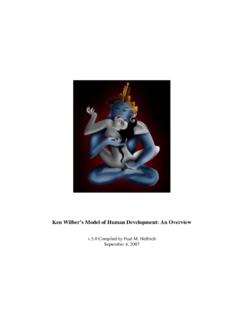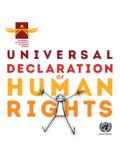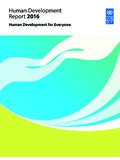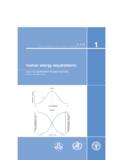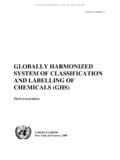Transcription of The World Health Report
1 The World Health ReportHEALTH SYSTEMS FINANCINGThe path to universal coverageEXECUTIVE SUMMARY World Health Organization 2010 All rights reserved. Publications of the World Health Organization can be obtained from WHO Press, World Health Organization, 20 Avenue Appia, 1211 Geneva 27, Switzerland (tel.: +41 22 791 3264; fax: +41 22 791 4857; e-mail: Requests for permission to reproduce or translate WHO publications whether for sale or for noncommercial distribution should be addressed to WHO Press, at the above address (fax: +41 22 791 4806; e-mail: designations employed and the presentation of the material in this publication do not imply the expression of any opinion whatsoever on the part of the World Health Organization concerning the legal status of any country, territory, city or area or of its authorities, or concerning the delimitation of its frontiers or boundaries.))
2 Dotted lines on maps represent approximate border lines for which there may not yet be full agreement. The mention of specific companies or of certain manufacturers products does not imply that they are endorsed or recommended by the World Health Organization in preference to others of a similar nature that are not mentioned. Errors and omissions excepted, the names of proprietary products are distinguished by initial capital reasonable precautions have been taken by the World Health Organization to verify the information contained in this publication. However, the published material is being distributed without warranty of any kind, either expressed or responsibility for the interpretation and use of the material lies with the reader.
3 In no event shall the World Health Organization be liable for damages arising from its use. This World Health Report was produced under the overall direction of Carissa Etienne, Assistant Director-General, Health Systems and Services and Anarfi Asamoa-Baah, Deputy Director General. The principal writers of the Report were David B Evans, Riku Elovainio and Gary Humphreys; with inputs from Daniel Chisholm, Joseph Kutzin, Sarah Russell, Priyanka Saksena and Ke Xu. Contributions in the form of boxes or analysis were provided by: Ole Doetinchem, Adelio Fernandes Antunes, Justine Hsu, Chandika K Indikadahena, Jeremy Lauer, Nathalie van de Maele, Belgacem Sabri, Hossein Salehi, Xenia Scheil-Adlung (ILO) and Karin and comments were received from Regional Directors, Assistant Directors-General and their , data and reviews of the outline, various drafts or specific sections were provided by (in addition to the people named above).
4 Dele Abegunde, Michael Adelhardt, Hector Arreola, Guitelle Baghdadi-Sabeti, Dina Balabanova, Dorjsuren Bayarsaikhan, Peter Berman, Melanie Bertram, Michael Borowitz, Reinhard Busse, Alexandra Cameron, Guy Carrin, Andrew Cassels, Eleonora Cavagnero, John Connell, David de Ferranti, Don de Savigny, Varatharajan Durairaj, Tam s Evetovits, Josep Figueras, Emma Fitzpatrick, Julio Frenk, Daniela Fuhr, Ramiro Guerrero, Patricia Hernandez Pena, Hans V Hogerzeil, Kathleen Holloway, Melitta Jakab, Elke Jakubowski, Christopher James, Mira Johri, Matthew Jowett, Joses Kirigia, Felicia Knaul, Richard Laing, Nora Markova, Awad Mataria, Inke Mathauer, Don Matheson, Anne Mills, Eduardo Missoni, Laurent Musango, Helena Nygren-Krug, Ariel Pablos-Mendez, Anne-Marie Perucic, Claudia Pescetto, Jean Perrot, Alexander Preker, Magdalena Rathe, Dag Rekve, Ritu Sadana, Rocio Saenz, Thomas Shakespeare, Ian Smith, Peter C Smith, Alaka Singh, Ruben Suarez Berenguela, Tessa Tan-Torres Edejer, Richard Scheffler, Viroj Tangcharoensathien, Fabrizio Tediosi, Sarah Thomson, Ewout van Ginneken, Cornelis van Mosseveld and Julia Watson.
5 The writing of the Report was informed by many individuals from various institutions who provided Background Papers; these Background Papers can be found at Michael Reid copy-edited the Report , Ga l Kernen produced figures and Evelyn Omukubi provided valuable secretarial and administrative support. Design and layout was done by Sophie Guetaneh Aguettant and Cristina Ortiz. Illustration by Edel Tripp ( ).Financial support from the Rockefeller Foundation, United States for International Development (USAID) and the Federal Ministry of Health , Germany, is gratefully in Switzerland on FSC - certified, 100% recycled paper. 34 Message from the Director-General7 Executive summary7 Why universal coverage?
6 8 Where are we now?9 How do we fix this?10 Raising sufficient resources for health12 Removing financial risks and barriers to access14 Promoting efficiency and eliminating waste16 Inequalities in coverage17An agenda for action17 Facilitating and supporting change19 Practical steps for external partners19A message of hope Contents4I commissioned this World Health Report in response to a need, expressed by rich and poor countries alike, for practical guidance on ways to finance Health care. The objective was to transform the evidence, gathered from studies in a diversity of settings, into a menu of options for raising sufficient resources and removing financial barriers to access, especially for the poor.
7 As indicated by the subtitle, the emphasis is firmly placed on moving towards universal coverage, a goal currently at the centre of debates about Health service need for guidance in this area has become all the more pressing at a time characterized by both economic downturn and rising Health -care costs, as populations age, chronic diseases increase, and new and more expensive treatments become available. As this Report rightly notes, growing public demand for access to high-quality, affordable care further increases the political pressure to make wise policy a time when money is tight, my advice to countries is this: before looking for places to cut spending on Health care, look first for opportunities to improve efficiency.
8 All Health systems, everywhere, could make better use of resources, whether through better procurement practices, broader use of generic products, better incentives for providers, or streamlined financing and administrative Report estimates that from 20% to 40% of all Health spending is currently wasted through inefficiency, and points to 10 specific areas where better policies and practices could increase the impact of expenditures, sometimes dramatically. Investing these resources more wisely can help countries move much closer to universal coverage without increasing the path to universal coverage, the Report identifies continued reliance on direct payments, including user fees, as by far the greatest obstacle to progress.
9 Abundant evidence shows that raising funds through required prepayment is the most efficient and equitable base for increasing population coverage. In effect, Message from the Director-General5such mechanisms mean that the rich subsidize the poor, and the healthy subsidize the sick. Experience shows this approach works best when prepayment comes from a large number of people, with subsequent pooling of funds to cover everyone s Health -care one in need of Health care, whether curative or preventive, should risk financial ruin as a the evidence shows, countries do need stable and sufficient funds for Health , but national wealth is not a prerequisite for moving closer to universal coverage.
10 Countries with similar levels of Health expenditure achieve strikingly different Health outcomes from their investments. Policy decisions help explain much of this the same time, no single mix of policy options will work well in every setting. As the Report cautions, any effective strategy for Health financing needs to be home-grown. Health systems are complex adaptive systems, and their different components can interact in unexpected ways. By covering failures and setbacks as well as successes, the Report helps countries anticipate unwelcome surprises and avoid them. Trade-offs are inevitable, and decisions will need to strike the right balance between the proportion of the population covered, the range of services included, and the costs to be despite these and other warnings, the overarching message is one of optimism.











